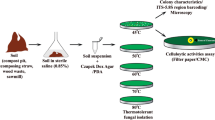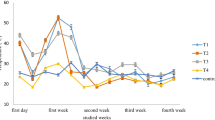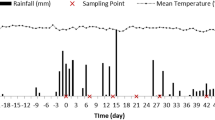Abstract
It was shown that inoculation of straw with cellulolytic fungi offers potential for manipulating and improving the composting of cellulose waste, where the C:N ratio is not optimal for composting. In this paper we report on a screening strategy used to isolate novel cellulolytic fungi from field samples. The screen comprised of two phases. In phase I, 300 cellulolytic fungi were isolated to pure culture from field samples collected from Hawaii, China and the UK. Isolates were selected on the basis of high cellulolytic activities and growth rates on cellulose agar. A total of 137 lead isolates progressed to an unreplicated phase II screen to rapidly identify strains that improved quality of the resulting compost over and above that of the uninoculated control. Compost quality was assessed by measuring C:N ratio, water holding capacity, water content and potential and polysaccharide content of the resulting compost. Effect on the aggregate stability of soil and the growth of wheat seedlings was assessed when compost was added to a sandy loam soil. Performance of each isolate was quantified by allocating a utility score for each compost analysed. Utility scores were based on the sum of the logged ranked score in each assay. The 10 highest scoring isolates were subsequently processed through a replicated phase II screen and the best performing isolates identified by calculating utility scores as before. Significantly lower C:N ratios, higher water-holding capacities and improved aggregate stabilities were obtained with some inoculated treatments compared to the uninoculated control, whilst the results obtained for polysaccharide content and plant growth showed no significant differences. Isolate 304, isolated from decomposing vegetation obtained from Egham, Surrey, UK, and identifed as a Trichurus sp., appeared the most effective inoculant, significantly decreasing the C:N ratio by 36% and increasing the aggregate stability of soil by 54% compared to the uninoculated control. As a result of adopting this screening strategy, it has been possible to identify cellulolytic fungi that can, under non-sterile (laboratory) conditions, significantly improve the quality of compost. This screening approach therefore offers real possibilities for selecting microbial inoculants in low-tech agricultural practices.
Similar content being viewed by others
References
Abd-Alla, M.H. & Omar, S.A. 1998 Wheat straw and cellololytic fungi application increases nodulation, nodule efficiency and growth of fenugreek (Trigonella foenum-graceum L.) grown in saline soil. Biology and Fertility of Soils 26, 58–65.
Alef, K. & Nannipieri, P. 1995 Methods in Applied Soil Microbiology and Biochemistry. London: Academic Press. ISBN0125138407.
Anwar, M.N. & Zaman, M.Z. 1994 Isolation of cellulolytic microorganisms and screening for cellulase activity. Bangladesh Journal of Microbiology 11, 49–54.
Aubert, J.P., Béguin, P. & Millet, J. 1988 Biochemistry and Genetics of Cellulose Degradation. FEMS Symposium, No. 43. London: Academic Press. ISBN0120675757.
Béguin, P. & Aubert, J. 1992 Cellulases. In Encyclopedia of Microbiology, vol. 1, ed. Lederberg J. pp. 467–477. San Diego: Academic press. ISBN0122268911.
de Bertoldi, M., Vallini, G. & Pera, A. 1983 The biology of composting. A review. Waste Management and Research 1, 157–176.
Chapman, S.J. & Lynch, J.M. 1985 Some properties of polysaccharides of microorganisms from degraded straw. Enzyme and Microbial Technology 7, 161–163.
Coughlan, M.P. 1989 Enzyme Systems for Lignocellulosic Degradation. London: Elsevier Applied Science. ISBN1851664114.
Domsch, K.H., Gams, W. & Anderson, T.H. 1980 Compendium of Soil Fungi, vol. 1. London: Academic Press. ISBN0122204204.
Dorado, J., Almendros, G., Camarero, S., Martinez, A.T., Vares, T. & Hatakka, A. 1999 Transformation of wheat straw in the course of solid-state fermentation by four lignolytic basidiomycetes. Enzyme and Microbial Technology 25, 605–612.
Dubois, M., Gilles, K.A., Hamilton, J.K., Rebers, P.A. & Smith, F. 1956 Colorimetric method for determination of sugars and related substances. Analytical Chemistry 3, 350–356.
Eriksson, K.E., Blanchette, R.A. & Ander, P. 1990 Microbial and Enzymatic Degradation of Wood and Wood Components. Berlin: Springer-Verlag. ISBN038751600X.
Gilmour, C.M., Allen, O.N. & Truog, E. 1948 Soil aggregation as in.uenced by the growth of mold species, kind of soil and organic matter. Soil Science Society of America Proceedings 13, 292–296.
Goldstein, I.S. 1981 Organic Chemicals from Biomass. Boca Raton, Florida: CRC Press. ISBN0849355311.
Goyal, A., Ghosh, B. & Eveleigh, D. 1991 Characteristics of fungal cellulases. Bioresource Technology 36, 37–50.
Halsall, D.M. & Gibson, A.H. 1985 Cellulose decomposition and associated nitrogen.xation by mixed cultures of Cellulomonas gelida and Azospirillum species or Bacillus macerans. Applied and Environmental Microbiology 50, 1021–1026.
Harper, S.H.T. & Lynch, J.M. 1984 Nitrogen.xation by cellulolytic communities of aerobic-anaerobic interfaces in straw. Journal of Applied Bacteriology 57, 131–137.
Kassas, M. 1995 Desertification - a general review. Journal of the Arid Environment 30, 115–128.
Kluepfel, D. 1988 Screening of prokaryotes for cellulose-and hemicellulose-degrading enzymes. Methods in Enzymology 160, 180–186.
Kostov, O., Ramkov, V., Lynch, J.M., 1991 Decomposition of sawdust and bark treated with cellulose decomposing microorganisms. Biology and Fertility of Soils 11, 105–110.
Lynch, J.M. & Bragg, E. 1985 Microorganisms and soil aggregate stability. Advances in Soil Science 2, 133–171.
Lynch, J.M. & Harper, S.H.T. 1974 Formation of ethylene by a soil fungus. Journal of General Microbiology 80, 187–195.
Lynch, J.M., Wilson, K.L., Ousley, M.A. & Whipps, J.M. 1991 Response of lettuce to Trichoderma treatment. Letters in Applied Microbiology 12, 59–61.
MAFF/ADAS 1986 The Analysis of Agricultural Materials. London: HMSO Books. ISBN0112427626.
Magan, N., Hand, P., Kirkwood, I.A. & Lynch, J.M. 1989 Establishment of microbial inocula on decomposing wheat straw in soil of different water contents. Soil Biology and Biochemistry 21, 15–22.
Mbah, B.N. & Odili, P.N. 1998 Changes in moisture retention properties of.ve waste materials during short-term mesophilic composting. Compost Science and Utilisation 6, 67–73.
O'Riordan, T. 2000 Environmental Science for Environmental Management. Harlow: Pearson Education. ISBN0582218896.
Ousley, M.A., Lynch, J.M. & Whipps, J.M. 1993. Effect of Trichoderma on plant growth: a balance between toxicity and growth promotion. Microbial Ecology 26, 277–285.
Rajbanshi, S.S., Endo, H., Sakamoto, K. & Inubushi, K. 1998 Stabilisation of chemical and biochemical characteristics of grass straw and leaf mix during in-vessel composting with and without seeding material. Soil Science and Plant Nutrition 44, 485–495.
Razvi, A.S. & Kramer, D.W. 1996 Evaluation of compost activators for composting grass clippings. Compost Science and Utilisation 4, 72–80.
Requena, N., Baca, T.M. & Azcon, R. 1997 Evolution of humic substances from unripe compost during incubation with lignolytic or cellulolytic microorganisms and e.ects on the lettuce growth promotion mediated by Azotobacter chroococcum. Biology and Fertility of Soils, 24, 59–65.
Romero, M.D., Aguado, J., Gonzalez, L. & Ladero, M. 1999 Cellulase production by Neurospora crassa on wheat straw. Enzyme and Microbial Technology 25, 244–250.
Shin, H.S., Hwang, E.J., Park, B.S. & Sakai, T. 1999 The effects of seed inoculation on the rate of garbage composting. Environmental Technology 20, 293–300.
Verstraete, W. & Top, E.M. 1999 Soil clean-up: lessons to remember. International Biodeterioration and Biodegradation 43, 147–153.
Villar, M.C., Gonzalez-Prieto, S.J. & Carballas, T. 1998 Evaluation of three organic wastes for reclaiming burnt soils: improvement in the recovery of vegetation cover and soil fertility in pot experiments. Biology and Fertility of Soils 26, 122–129.
Volokita, M., Abeliovich, A. and Soares, M.I.M. 2000 Detection of microorganisms with overall cellulolytic activity. Current Microbiology 40, 135–136.
Wallace, A. 1994 Soil organic matter is essential to solving soil and environmental problems. Communications in Soil Science and Plant Analysis 25, 15–28.
Author information
Authors and Affiliations
Rights and permissions
About this article
Cite this article
Hart, T., De Leij, F., Kinsey, G. et al. Strategies for the isolation of cellulolytic fungi for composting of wheat straw. World Journal of Microbiology and Biotechnology 18, 471–480 (2002). https://doi.org/10.1023/A:1015519005814
Issue Date:
DOI: https://doi.org/10.1023/A:1015519005814




